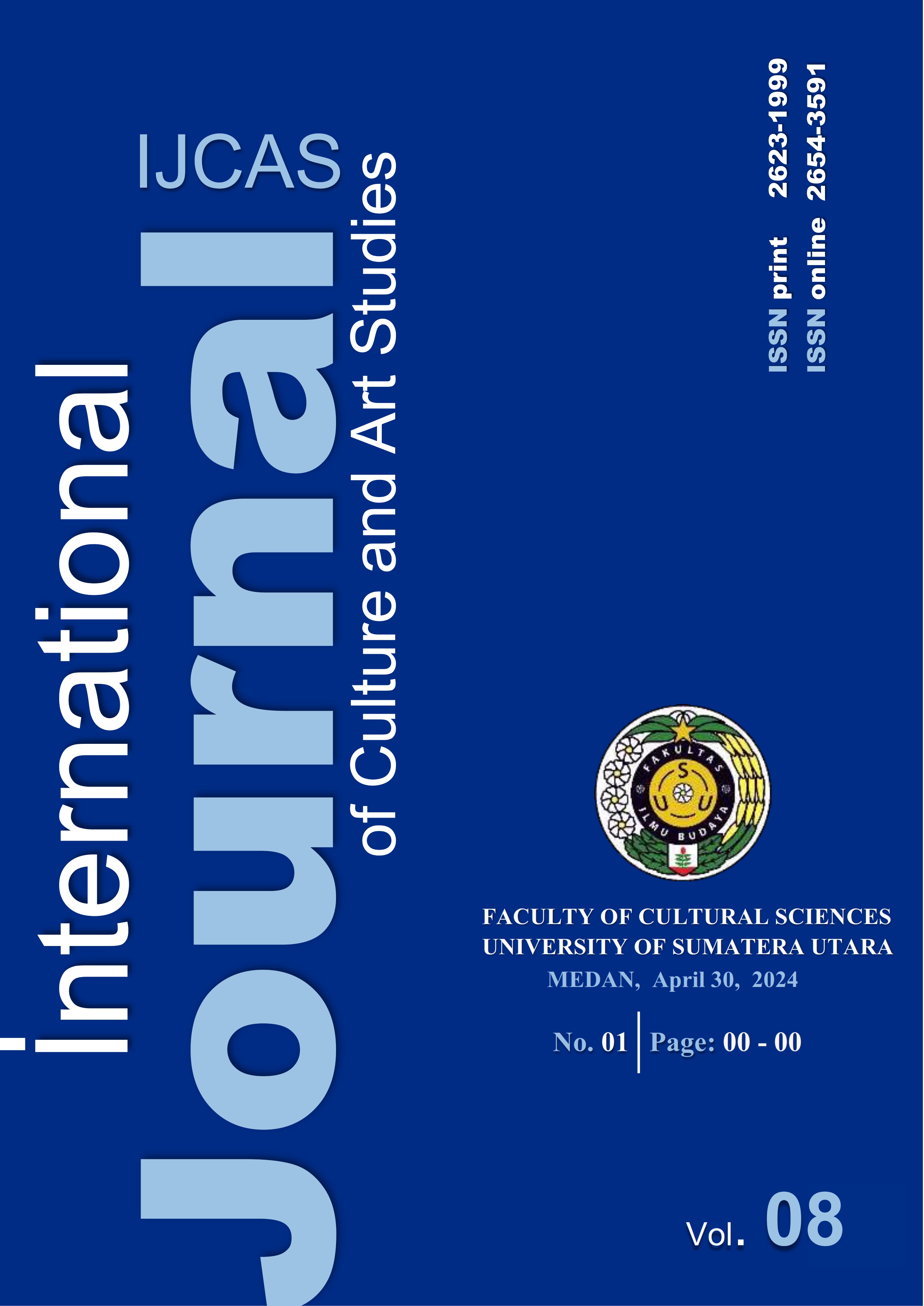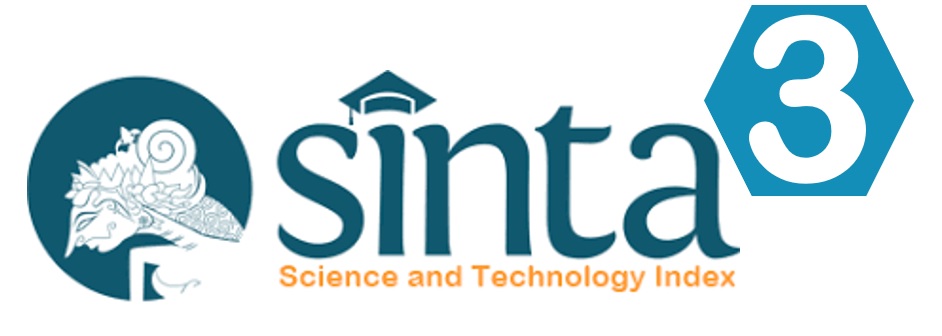Exploring the Linguistic Landscape of Public Elementary Schools in Medan: Understanding Forms and Functions
DOI:
https://doi.org/10.32734/ijcas.v8i1.16989Keywords:
Schoolscape, linguistic landscape, public elementary school, MedanAbstract
The linguistic landscape, or "schoolscape," in public elementary schools in Medan, Indonesia, is a relatively new area of study in linguistics. This descriptive qualitative research explores language use within the school environment, considering its social and cultural aspects. The study aims to analyze the linguistic forms, usage, and functions present in the linguistic landscape of these schools. Data from photographs capturing linguistic units was collected from four public elementary schools in Medan. This study employed systematic sampling, specifically purposive sampling, to select public elementary schools in Medan based on criteria related to the city's main areas with diverse linguistic units. The findings reveal various linguistic forms, including acronyms, words, phrases, sentences, and monolingual and bilingual texts. Language within the linguistic landscape serves informational and symbolic functions, providing information to readers and reflecting the relationship between language and power through linguistic signs associated with local leaders. While Indonesian is the dominant language used, there is a lack of representation of specific ethnic or cultural identities. The findings have global implications, revealing language's role in education and its impact on social and cultural dynamics. Understanding linguistic forms, usage, and functions provides valuable insights for education policies promoting language diversity, skills, and cultural inclusivity. The study suggests enriching the linguistic landscape by considering the use of local or minority languages existing in the region. This study contributes to understanding linguistic landscapes in Indonesian schools and highlights the importance of incorporating diverse languages to promote language proficiency and cultural preservation.
Downloads
References
Agustono, B., Dewi, H., & Pujiono, M. (2020). Penanaman nilai-nilai multikulturalisme melalui sejarah Tjong Afie di kota Medan pada mahasiswa Fakultas Bahasa dan Komunikasi Universitas Harapan Medan. LOGISTA - Jurnal Ilmiah Pengabdian Kepada Masyarakat, 4(1), 49. https://doi.org/10.25077/logista.4.1.49-56.2020
Anwariyah. (2023). Akronim, singkatan, dan istilah di masa pandemi covid-19. Narasi: Jurnal Kajian Bahasa, Sastra Indonesia, Dan Pengajarannya, 1(1), 24–45. https://doi.org/10.30762/narasi.v1i1.899
Ayae, A., & Savski, K. (2023). Echoes of the past, hopes for the future: examining temporalised schoolscapes in a minority region of Thailand. International Journal of Multilingualism, 1–20. https://doi.org/10.1080/14790718.2022.2164770
Batubara, F., Derin, T., Putri, N. S., & Yudar, R. S. (2020). Five factors influencing the students’ motivation to learn English as a foreign language: a closer look into montessori classroom environment. REiLA : Journal of Research and Innovation in Language, 2(2), 76–84. https://doi.org/10.31849/reila.v2i2.3165
Biró, E. (2016). Learning schoolscapes in a minority setting. Acta Universitatis Sapientiae, Philologica, 8(2), 109–121. https://doi.org/10.1515/ausp-2016-0021
Brown, K. D. (2012). The linguistic landscape of educational spaces: language revitalization and schools in Southeastern Estonia. In Minority Languages in the Linguistic Landscape (pp. 281–298). London: Palgrave Macmillan UK. https://doi.org/10.1057/9780230360235_16
Erikha, F. (2018). Konsep lanskap linguistik pada papan nama jalan kerajaan (Râjamârga): Studi Kasus di Kota Yogyakarta. Paradigma, Jurnal Kajian Budaya, 8(1), 38. https://doi.org/10.17510/paradigma.v8i1.231
Ferdiyanti, I. N. (2016). Multilingualisme dalam Lanskap Linguistik di Wilayah Kota Surabaya (UNIVERSITAS AIRLANGGA). UNIVERSITAS AIRLANGGA. Retrieved from http://repository.unair.ac.id/29956/
Fitria, S. L., & Mulyono. (2023). Kontestasi Bahasa di Mal Royal Plaza Surabaya : Kajian Lanskap Linguistik. BAPALA, 10(4), 1–14. Retrieved from https://ejournal.unesa.ac.id/index.php/bapala/article/view/54731
Gapur, A., & Mulyadi, M. (2018). Studi kontrastif konstruksi interogatif polar bahasa Jepang dan bahasa Indonesia. GENTA BAHTERA: Jurnal Ilmiah Kebahasaan Dan Kesastraan, 4(1), 23–32. https://doi.org/10.47269/gb.v4i1.43
Gorter, D. (2006). Introduction: The Study of the Linguistic Landscape as a New Approach to Multilingualism. International Journal of Multilingualism, 3(1), 1–6. https://doi.org/10.1080/14790710608668382
Gorter, D. (2018a). 2. Methods and Techniques for Linguistic Landscape Research: About Defi nitions, Core Issues and Technological Innovations. In M. Pütz & N. Mundt (Eds.), Expanding the Linguistic Landscape (pp. 38–57). Bristol, Blue Ridge Summit: Multilingual Matters. https://doi.org/10.21832/9781788922166-005
Gorter, D. (2018b). Linguistic landscapes and trends in the study of schoolscapes. Linguistics and Education, 44, 80–85. https://doi.org/10.1016/j.linged.2017.10.001
Gortre, D., & Cenoz, J. (2014). Linguistic Landscapes inside Multilingual Schools. In Challenges for Language Education and Policy (1st Editio). Routledge.
Harahap, R. N. M., & Cucu Gina Cahyani. (2023). Analisis Frasa Berdasarkan Kategori Kelas Kata pada Cuitan Twitter Tokoh Nasional. Imajeri: Jurnal Pendidikan Bahasa Dan Sastra Indonesia, 5(2), 147–161. https://doi.org/10.22236/imajeri.v5i2.10583
Hardini, T. I., Widyastuti, T., & Awaliah, Y. R. (2018). Peran bahasa Indonesia, daerah, dan asing dalam strategi pemasaran kue artis di kota Bandung. Jakarta. Retrieved from https://repositori.kemdikbud.go.id/10055/
Jumlah Sekolah Dasar Menurut Kecamatan dan Status Sekolah (Jiwa), 2013. (2013). Retrieved September 11, 2023, from Badan Pusat Statistik Kota Medan website: https://medankota.bps.go.id/indicator/28/45/1/jumlah-sekolah-dasar-menurut-kecamatan-dan-status-sekolah.html
Khoirunnisa, K., Sumarlam, S., & Nugroho, M. (2023). Tipologi Abreviasi dan Akronim: Titik Pijak Awal Pemanfaatan Semantik dalam Penyusunan Kamus Bahasa Indonesia. GHANCARAN: Jurnal Pendidikan Bahasa Dan Sastra Indonesia, 4(2). https://doi.org/10.19105/ghancaran.v4i2.6831
Kurniawan, H., Moehkardi, R., & Muliawati, N. (2024). Revisiting the English status in the outer and expanding circles: Insights from google street view®. LLT Journal: A Journal on Language and Language Teaching, 27(1), 461–497. https://doi.org/10.24071/llt.v27i1.7659
Landry, R., & Bourhis, R. Y. (1997). Linguistic Landscape and Ethnolinguistic Vitality. Journal of Language and Social Psychology, 16(1), 23–49. https://doi.org/10.1177/0261927X970161002
Maharani, W. A. (2019). Penggunaan bahasa Inggris dalam penulisan produk dan jasa fotokopi dan percetakan di Margonda, Depok. Konferensi Linguistik Tahunan Atma Jaya , (17), 517–521. Jakarta: Universitas Katolik Indonesia Atma Jaya.
McManus, D. (2023). Repetition, Parallelism and Antonymous Verbal Phrases in Early and Classical Modern Irish. Ériu. https://doi.org/10.1353/eri.0.0007
Mufrida, F., & Zultiyanti, Z. (2023). Proses pembentukan akronim dan singkatan pada berita harian detik.com. Aksara: Jurnal Ilmiah Pendidikan Bahasa Dan Sastra Indonesia, 7(1), 67. https://doi.org/10.33087/aksara.v7i1.494
Muriungi, S. W., & Mudogo, B. A. (2021). Linguistic landscape in a multilingual context: a case of Kenyan universities. LLT Journal: A Journal on Language and Language Teaching, 24(2), 450–460. https://doi.org/10.24071/llt.v24i2.3673
Nasution, Z. (2007). Bahasa sebagai Alat Komunikasi Politik dalam Rangka Mempertahankan Kekuasaan. Sodality: Jurnal Sosiologi Pedesaan, 1(3). https://doi.org/10.22500/sodality.v1i3.5897
Restyana, A. (2016). Pelesapan Objek pada Dialog Drama Wakamonotachi Karya Shigemichi Sugita (æˆé“æ‰ç”°ã€Œè‹¥è€…ãŸã¡ã€ã«ãŠã‘る対象語ã®çœç•¥). UNIVERSITAS DIPONEGORO.
Revita, Y., Marsidin, S., & Sulastri, S. (2023). Peran Bahasa dalam Penerapan Ilmu Pengetahuan. Journal on Education, 5(2), 2981–2987. https://doi.org/10.31004/joe.v5i2.949
Sahril, S., Harahap, S. Z., & Hermanto, A. B. (2019). Lanskap linguistik kota Medan: Kajian onomastika, semiotika, dan spasial. MEDAN MAKNA: Jurnal Ilmu Kebahasaan Dan Kesastraan, 17(2), 195. https://doi.org/10.26499/mm.v17i2.2141
Sari, D. P. R. (2020). Linguistik lanskap di sekolah-sekolah Islam tingkat menengah atas di Surakarta (Universitas Negeri Surakarta). Universitas Negeri Surakarta. Retrieved from https://digilib.uns.ac.id/dokumen/detail/81756/Linguistik-Lanskap-di-Sekolah-Sekolah-Islam-Tingkat-Menengah-Atas-di-Surakarta
Scarvaglieri, C. (2017). ‘Educational Landscaping’: a method for raising awareness about language and communication. Language Awareness, 26(4), 325–342. https://doi.org/10.1080/09658416.2017.1411358
Widiyanto, H., Emzir, & Muliastuti, L. (2021). Fungsi Sosial, Struktur, dan Ciri Kebahasaan Teks Iklan di Lanskap Linguistik Sekolah: Kajian Teori Linguistik Sistemik Fungsional. MABASAN, 15(1), 35–54. https://doi.org/10.26499/mab.v15i1.422
Yendra, & Artawa, K. (2020). Lanskap Linguistik Pengenalan, Pemaparan, dan Aplikasi. Deepublish Publisher.
Zubizarreta, M. L. (2022). The Verbal Phrase in Paraguayan Guarani: A Case Study on the Role of Prosody in Linearization. Languages, 7(3), 221. https://doi.org/10.3390/languages7030221
Downloads
Published
How to Cite
Issue
Section
License
Copyright (c) 2024 Abdul Gapur, Taulia, Muhammad Kiki Wardana

This work is licensed under a Creative Commons Attribution-ShareAlike 4.0 International License.













